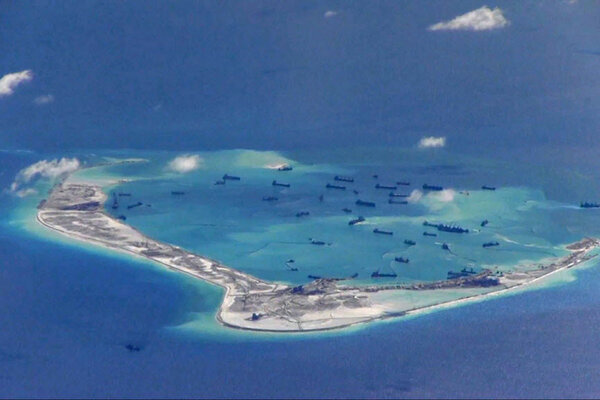In the wake of an international court's ruling rejecting China's claims to disputed territory in the South China Sea, China said the combat exercises were an effort to protect its 'maritime interests.'

Chinese dredging vessels are purportedly seen in the waters around Mischief Reef in the disputed Spratly Islands in the South China Sea in an image taken by US Navy aircraft in May 2015. This week, China's air force said it was flying 'combat patrols' over the disputed islands in the wake of its rejection of an international court ruling that overruled China's claims to the territory. U.S. Navy/Handout/Reuters/Files
China’s air force has sent bombers and fighter jets on “combat patrols” near the islands at the center of a long-running territorial dispute in the South China Sea, a senior colonel said, according to the Xinhua news agency.
“The Air Force is organizing normalized South China Sea combat patrols, practicing tactics ... increasing response capabilities to all kinds of security threats and safeguarding national sovereignty, security and maritime interests,” Senior Col. Shen Jinke of the People’s Liberation Army Air Force told Xinhua, Reuters reports.
The exercises, which are focusing on the airspace around the Spratly Islands and Scarborough Shoal, come as tensions have increased in the wake of a recent international court ruling in The Hague that rejected China’s claims to a broad swath of territory in the South China Sea.
Further north, another confrontation is brewing. On Saturday, Japan officially protested after six Chinese coast guard vessels (at least three were armed with gun batteries, Japan said) approached disputed East China Sea islands along with a fleet of hundreds of Chinese fishing boats.
Asked about Japan's statement, China's Foreign Ministry reiterated its position that the islands are "China's inherent territory" and that it has "indisputable sovereignty" over them and their adjacent waters.
China, which lays historical claim to the “nine-dash line,” encompassing as much as 90 percent of the sea, refused to recognize the court’s ruling last month. The dispute is complex, involving conflicting claims from the Philippines, Taiwan, Vietnam, Malaysia and Brunei.
Some observers told the Christian Science Monitor last month that China would particularly watch the responses of the US and the Philippines, which brought the court ruling in part because of a dispute over Scarborough Shoal, a reef 140 miles from the Philippine coast.
Last week, China’s Defense Ministry announced that it would begin holding joint military exercises with Russia in September, in an action that appeared to be particularly aimed at the US, which has argued China should respect the court’s ruling.
Russia has supported China’s territorial claims in the South China Sea and its rejection of the court ruling, pointing to what it calls the US’ “meddling” in the region, the Monitor reported.
In what’s increasingly become a tit for tat conflict, both China and the US have said they are not directly trying to provoke aggression. Last week, Yang Yujun, a spokesman for the China Defense Ministry said the land and sea exercises will be “routine” and will not “target any third party.”
In January, a US naval ship conducted a patrol around the disputed Triton Island, as part of a strategy designed to decrease tensions, the Monitor reported.
“The U.S. government takes no position on the territorial disputes in the Spratly Islands, but does take a strong position on what kinds of claims are made to the waters surrounding those features,” an analysis by the Center for Strategic and International Studies (CSIS) noted.
This week, according to Xinhua, China’s air force sent several H-6 bombers and Su-30 fighter jets to the airspace over the disputed islands, Reuters reports. The patrols also include surveillance and refueling aircraft, but it’s not clear when exactly they occurred.
Many of China’s claims center on the building it has done on top of reefs and rocky outcroppings that it argues give it international rights to further develop around the waters surrounding these “islands,” the Monitor reported.
With Philippines President Rodrigo Duterte indicating that he would be open to negotiations with China, it’s also possible that a round of peaceful negotiations, rather than further escalation of the conflict, could eventually occur, though when that might happen is unclear, some analysts told the Monitor.
“The initial one or two weeks are going to be very interesting, with people probably prone to over-analyzing the situation,” Taylor Fravel, an associate professor of political science at the Massachusetts Institute of Technology, told the Monitor after the court’s ruling last month. “But it is not preordained that escalation will happen; it’s not in the Chinese or US interest.”
http://www.csmonitor.com/World/Asia-Pacific/2016/0806/Why-is-China-flying-combat-patrols-over-Spratly-Islands

No comments:
Post a Comment
Note: Only a member of this blog may post a comment.